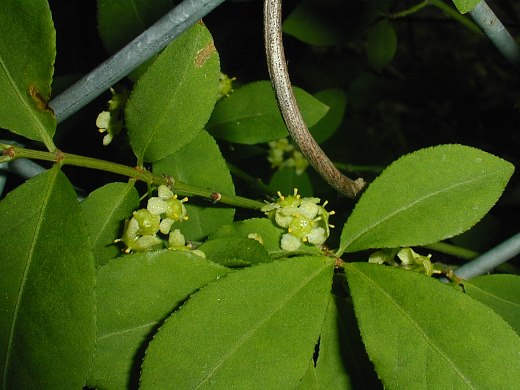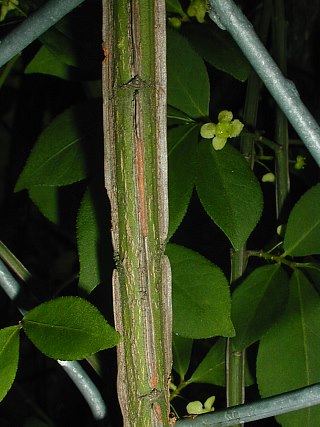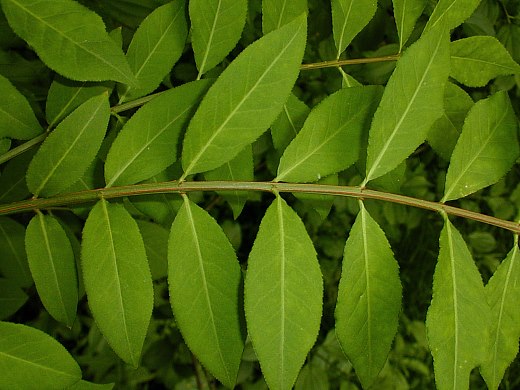Description: Winged Euonymus is a single or multistemmed shrub that becomes 6-12' tall at maturity. This shrub has a densely branched crown that is often as wide as it is tall. The bark of large old stems is gray or brownish gray and slightly furrowed. Smaller stems are green with 2-4 brown corky wings. The corky wings are occasionally interrupted by the development of new leaves or branches. Pairs of opposite leaves occur along young shoots. Individual leaves are 1-2" long and ½-1" across; they are elliptic to broadly elliptic and finely serrated along their margins. The slender petioles are very short (about 1/8" or 3 mm. in length). Upper leaf surfaces are medium to dark green, while their lower surfaces are a paler shade of green; both surfaces are hairless.

Small cymes of 3
flowers (or less) develop from the axils of the leaves. The peduncle of
the cyme is up to 1" long, while the slender pedicels of individual
flowers are up to ½" long. Individual flowers are about 1/3" (8 mm.)
across,
consisting of 4 yellowish green petals, 4 green sepals, 4 short
stamens, and a central green disk, from which a multilobed stigma
develops. The petals are well-rounded and widely spreading when a
flower is fully open. The blooming period occurs during early summer
and lasts about 3 weeks. During the summer, fertile flowers develop
into 4-lobed seed capsules with smooth sides. At maturity during the
fall, the seed capsules are up to ½" long and their exteriors become
dark red or purple. Each capsule splits open along the margins of its
lobes to reveal 1-4 orange-red arils. The fleshy exterior of each aril
contains a single ellipsoid seed up to 1/3" (8 mm.) long. The deciduous
leaves
become bright red during the autumn before they fall to the ground.
Cultivation:
This adaptable shrub tolerates full sun to medium shade, moist to
dry-mesic conditions, and many soil types. It has rather slow growth
and development.

Range &
Habitat:
The non-native Winged Euonymus has naturalized in only a few counties
in Illinois (see
Distribution
Map), where it is uncommon to occasional. However, official
records
probably underestimate the true distribution of this shrub, as it
appears to be spreading into new areas of the state. This
shrub was
introduced into North America as a landscape plant from NE Asia, where
it is native to parts of Russia, China, Korea, and Japan. Typical
habitats include disturbed woodlands, woodland borders, thickets,
vacant lots, roadsides, and fence rows. This shrub is often cultivated
in lawns and along highways; it usually naturalizes near urban and
suburban areas.
Faunal Associations:
The inconspicuous flowers are cross-pollinated primarily by small bees
and flies. Winged Euonymus is a host plant of Unaspis euonymi
(Euonymus Scale), Lepidosaphes yanangicola (Winged
Euonymus Scale), the wood-boring larvae of the long-horned beetle Stenocorus
cinnamoptera, the caterpillars of the Pyralid moth Herpetogramma
thestealis and Yponomeuta multipunctella
(American Ermine Moth), and Otiorhynchus sulcatus
(Black Vine Weevil). The larvae of Black Vine Weevil consume feeder
roots, while the adults feed on the leaves. Winged Euonymus is one of
the winter hosts of Aphis rumicis (Bean Aphis).
Birds (largely unidentified) eat the fleshy arils and spread their
seeds to new locations. White-Tailed Deer avoid the foliage of Winged
Euonymus. As a result, this shrub has a tendency to increase in wooded
areas where these animals are abundant. Because of its dense branching
structure, Winged Euonymus provides good cover and nesting habitat for
many songbirds.
Photographic Location:
Along a fence row behind the webmaster's apartment in Urbana, Illinois.

Comments: Winged Euonymus is readily distinguished from similar shrubs by the prominent corky wings of its branches. In addition to the corky wings, some of its more interesting features include the bright red coloration of the leaves during the autumn, the bright orange-red arils, and its compact habit of growth. This introduced shrub has become invasive in some New England states, where it can form sizable colonies in wooded areas that displace other plants, and it appears to be following a similar trajectory in Illinois and neighboring Midwestern states. Another common name for this species is Burning Bush.